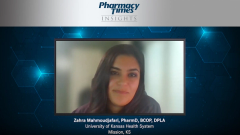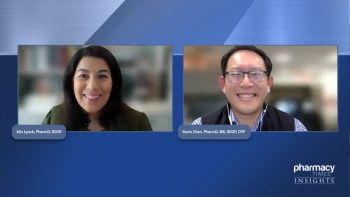
Exploring Toxicity Profiles and Pharmacists’ Roles within Treatment Management for CLL
In her closing thoughts, Dr Mahmoudjafari provides an overview of cardiovascular implications associated with CLL as well as the impact of pharmacists in CLL treatment management.
Zahra Mahmoudjafari, PharmD, BCOP, DPLA: With the management of any disease state, there’s frequent monitoring. CLL [chronic lymphocytic leukemia] is no exception. There are 3 BTK [Bruton tyrosine kinase] inhibitors—ibrutinib, acalabrutinib, and zanubrutinib—and each is a little different in its own way. They have their own dosing regimens and toxicities. Some are taken multiple times a day; some are taken once a day. Some of them have their own drug interactions. They’re unique in certain ways. With ibrutinib, we see any-grade atrial fibrillation in 4% to 17% of patients in the clinical trials, most frequently among older patients. We also see hypertension with grade 3 or higher events in up to a third of patients and lower-grade hypertension in even more patients. We definitely know that, and we’re able to manage them supportively in most cases.
In a recent pooled analysis, we found that ibrutinib is associated with higher risks for atrial fibrillation, bleeding, and heart failure but not necessarily with acute MI [myocardial infarction] or stroke. We see low-grade bruising at very high rates, but grade 3 or higher bleeding or major hemorrhages are uncommon. Ventricular arrhythmias are rare with ibrutinib, but they do occur. That’s something to keep in mind because it has an impact on significant morbidity and mortality. In a patient with cardiovascular disease, we would typically have a low threshold to use alternative therapies.
There are data demonstrating that if a patient doesn’t tolerate ibrutinib, they may tolerate acalabrutinib and/or zanubrutinib. Acalabrutinib and zanubrutinib were both designed to have more specificity for inhibiting BTK, as opposed to other kinases, and they result in fewer off-target effects. With acalabrutinib, many toxicities occur at lower rates. Grade 3 bleeding occurs at a similar rate with acalabrutinib and ibrutinib, although other toxicities are generally less frequent with acalabrutinib.
Another class effect with the BTK inhibitors is that they’re associated with lymphocytosis. We’re aware of that based on their mechanism of action. Essentially, BTK inhibits various adhesion molecules in the lymph node microenvironment. What happens is that the CLL cells leave the lymph nodes and enter the peripheral blood. We educate that the white blood cell count in these patients would rise substantially, so that patients and their family members won’t be concerned when they see that rise. It’s generally not associated with tumor lysis or complications from hyperleukocytosis.
Alternatively, 1 big toxicity associated with venetoclax includes neutropenia. This is managed differently based on when it occurs. For early neutropenia, we recommend treating through it because that treatment is riding the bone marrow of CLL cells. This will open the marrow for normal hematopoiesis. Over time, we’ll see the patient’s absolute neutrophil count rising. If the patient experiences neutropenia—say, several months into therapy—on the targeted dose, and they started with a normal white blood cell count, then we would certainly consider holding the venetoclax to wait for our counts to recover and then restart therapy. It’s not a 1-size fits all approach.
For CLL and all our hematologic malignancies, there’s no shortage of areas in which a pharmacist can help improve patient outcomes. They can be critical in treatment selection and assessment of first-line options and the management of the many toxicities associated with treatment. Another big area is all the supportive care involved with CLL, both for toxicities of the agents used but also for the disease characteristics themselves. These patients are often cytopenic and therefore on anti-infective prophylaxis. I refer to these as the trifecta because we have prophylaxis for bacterial, viral, and fungal infections. Often these patients have hypogammaglobulinemia, and we have to manage their IVIG [intravenous immunoglobulin]. Depending on other symptoms in bulky disease, pharmacists can help manage any potential tumor lysis syndrome, and there’s no shortage of places in which pharmacists can be involved in the management and care of patients with CLL.
The most important takeaway is that the frontline therapy of CLL and the management of frontline CLL therapy is bright. We have lots of options, and many of them are very effective. We have more on the horizon. We’re constantly getting better with our data and our research. For most patients, targeted therapies are preferred to chemoimmunotherapy, but the choice of targeted therapy is determined by patient preference and sometimes safety considerations. Ongoing and future studies will be crucial to continue to move our field forward. I always recommend considering enrolling patients in active clinical trials to help contribute toward improvement in care for patients with CLL. Of course, I’ll make 1 final plug to make sure that there’s a pharmacist involved in the care of these patients—for treatment selection, adverse event management, and supportive care—to ensure optimal outcomes.
Transcript edited for clarity.
Newsletter
Stay informed on drug updates, treatment guidelines, and pharmacy practice trends—subscribe to Pharmacy Times for weekly clinical insights.












































































































































































































